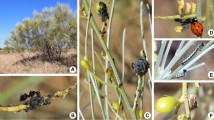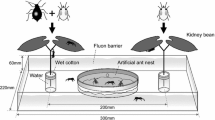Abstract
Ant-aphid relationships provide excellent opportunities to study how changes in resource availability may affect the outcome of competitive interactions. Variations in soil fertility may affect host plant quality, with concomitant effects on aphid abundance and the amount/quality of aphid honeydew. This may determine the intensity at which tending ants defend aphids against natural enemies and competing ants. In a shrub-steppe of northern Patagonia, aphid-infested thistles naturally grow on contrasting fertility substrates: organic waste piles of leaf-cutting ants (refuse dumps) and nutrient-poor steppe soils. Thistles growing on refuse dumps have much larger aphid colonies than thistles growing on steppe soils. We took advantage of the co-occurrence in the field of plants with contrasting aphid density to study the effect of natural variation in food availability (aphid density) on aphid-tending ant species richness and agonistic interactions among them. Enhanced aphid density did not promote the coexistence of aphid-tending ant species. Although all ant species are potential colonizers of the study plants, thistles were often monopolized by a single ant species, regardless of aphid density. Field experiments showed that increased aphid density did not modify aggressiveness toward an intruder ant, nor the probability of coexistence between two rival ant species after the invasion of a host plant. We discuss several hypotheses to explain why increased resource availability does not necessarily reduce competitive interactions in ant-aphid relationships.



Similar content being viewed by others
References
Blüthgen N, Fiedler K (2004) Competition for composition: lessons from nectar-feeding ant communities. Ecology 85:1479–1485
Blüthgen N, Verhaagh M, Goitía W, Jaffé K, Morawetz W, Barthlott W (2000) How plants shape the ant community in the Amazonian rainforest canopy: the key role of extrafloral nectaries and homopteran honeydew. Oecologia 125:229–240
Cerdá X, Retana J, Manzaneda A (1998) The role of competition by dominants and temperature in the foraging of subordinate species in Mediterranean ant communities. Oecologia 117:404–412
Chang CC, Smith MD (2014) Resource availability modulates above-and below-ground competitive interactions between genotypes of a dominant C4 grass. Funct Ecol 28:1041–1051
Correa MN (1969) Flora patagónica. INTA, Buenos Aires
Cushman JH (1991) Host-plant mediation of insect mutualisms: variable outcomes in herbivore-ant interactions. Oikos 61:138–144
Davidson DW (1997) The role of resource imbalances in the evolutionary ecology of tropical arboreal ants. Biol J Linn Soc 61:153–181
Davidson DW (1998) Resource discovery versus resource domination in ants: a functional mechanism for breaking the trade off. Ecol Entomol 23:484–490
Davidson DW (2005) Ecological stoichiometry of ants in a New World rain forest. Oecologia 142:221–231
Davidson DW, Cook SC, Snelling RR, Chua TH (2003) Explaining the abundance of ants in lowland tropical rainforest canopies. Science 300:969
Davidson DW, Longino JT, Snelling RR (1988) Pruning of host plant neighbors by ants: an experimental approach. Ecol 69:801–808
Davis MA, Wrage KJ, Reich PB (1998) Competition between tree seedlings and herbaceous vegetation: support for a theory of resource supply and demand. J Ecol 86:652–661
Del-Claro K, Oliveira PS (2000) Conditional outcomes in a neotropical treehopper-ant association: temporal and species-specific variation in ant protection and homopteran fecundity. Oecologia 124:156–165
Dimarco RD, Farji-Brener AG, Premoli AC (2010) Dear enemy phenomenon in the leaf-cutting ant Acromyrmex lobicornis: Behavioral and genetic evidence. Behav Ecol 21:304–310
Dixon AFG (1998) Aphid ecology: an optimization approach. Chapman & Hall, London
Douglas AE (2003) The nutritional physiology of aphids. Adv Insect Physiol 31:73–140
Douglas AE (2006) Phloem-sap feeding by animals: problems and solutions. J Exp Bot 57:747
Farji-Brener AG (2000) Leaf-cutting ant nests in temperate environments: mounds, mound damages and nest mortality rate in Acromyrmex lobicornis. Stud Neotrop Fauna E 35:131–138
Farji-Brener AG, Ghermandi L (2000) Influence of nests of leaf-cutting ants on plant species diversity in road verges of northern Patagonia. J Veg Sci 11:453–460
Farji-Brener AG, Ghermandi L (2008) Leaf-cutting ant nests near roads increase fitness of exotic plant species in natural protected areas. P Roy Soc B Biol Sci 275:1431–1440
Farji-Brener AG, Gianoli E, Molina-Montenegro MA (2009) Small-scale disturbances spread along trophic chains: Leaf-cutting ant nests, plants, aphids, and tending ants. Ecol Res 24:139–145
Gebauer RL, Schwinning S, Ehleringer JR (2002) Interspecific competition and resource pulse utilization in a cold desert community. Ecology 83:2602–2616
Grover CD, Kay AD, Monson JA, Marsh TC, Holway DA (2007) Linking nutrition and behaviourbehavioral dominance: carbohydrate scarcity limits aggression and activity in Argentine ants. P Roy Soc B Biol Sci 274:2951–2957
Helms KR, Vinson SB (2002) Widespread association of the invasive ant Solenopsis invicta with an invasive mealybug. Ecology 3:2425–2438
Helms KR, Vinson SB (2008) Plant resources and colony growth in an invasive ant: The importance of honeydew-producing hemiptera in carbohydrate transfer across trophic levels. Environ Entomol 37:487–493
Lescano MN, Farji-Brener AG, Gianoli E, Carlo TA (2012) Bottom-up effects may not reach the top: the influence of ant-aphid interactions on the spread of soil disturbances through trophic chains. P Roy Soc B Biol Sci 279:3779–3787
Lescano MN, Farji Brener AG, Gianoli E (2014) Nocturnal resource defence in aphid-tending ants of northern Patagonia. Ecol Entomol 39(203):209
Luiselli L (2006) Resource partitioning and interspecific competition in snakes: the search for general geographical and guild patterns. Oikos 144:193–211
Matthiessen B, Mielke E, Sommer U (2010) Dispersal decreases diversity in heterogeneous metacommunities by enhancing regional competition. Ecology 91:2022–2033
Moreira VS, Del-Claro K (2005) The outcomes of an ant-treehopper association on Solanum lycocarpum St. Hill: increased membracid fecundity and reduced damage by chewing herbivores. Neotrop Entomol 34(6):881–887
Nagamitsu T, Inoue T (1997) Aggressive foraging of social bees as a mechanism of floral resource partitioning in an Asian tropical rainforest. Oecologia 110:432–439
Ness JH, Morris WF, Bronstein JL (2009) For ant-protected plants, the best defense is a hungry offense. Ecology 90:2823–2831
Oliveira PS, Del-Claro K (2005) Multitrophic interactions in a neotropical savanna: ant-hemipteran systems, associated insect herbivores and a host plant. In: Burslem D, Pinard M, Hartley S (eds) Biotic interactions in the tropics: their role in the maintenance of species diversity. Cambridge University Press, New York, pp 414–438
Palmer TM, Stanton ML, Young TP, Goheen JR, Pringle RM, Karban R (2008) Breakdown of an ant-plant mutualism follows the loss of large herbivores from an African savanna. Science 319:192–195
Powers DR, McKee T (1994) The effect of food availability on time and energy expenditures of territorial and non-territorial hummingbirds. Condor 96:1064–1075
Ray JC, Sunquist ME (2001) Trophic relations in a community of African rainforest carnivores. Oecologia 127:395–408
Rees M (2013) Competition on productivity gradients—what do we expect? Ecol Lett 16:291–298
Ribas CR, Schoereder JH, Pic M, Soares SM (2003) Tree heterogeneity, resource availability, and larger scale processes regulating arboreal ant species richness. Aust Ecol 28:305–314
Rico-Gray V, Oliveira PS (2007) The ecology and evolution of ant-plant interactions. University of Chicago Press
Satti P, Mazzarino M, Gobbi M, Funes F, Roselli L, Fernández H (2003) Soil N dynamics in relation to leaflitter quality and soil fertility in northwestern Patagonian forests. J Ecol 91:173–181
Styrsky JD, Eubanks MD (2007) Ecological consequences of interactions between ants and honeydew-producing insects. Proc R Soc B Biol Sci 274:151–164
Tsvuura Z, Kirkman KP (2013) Yield and species composition of a mesic grassland savanna in South Africa are influenced by long-term nutrient addition. Aust Ecol 38:959–970
Vepsalainen K, Savolainen R (1990) The effect of interference by formicine ants on the foraging of Myrmica. J Anim Ecol 59:643–654
Wilson JB (1988) Shoot competition and root competition. J Appl Ecol 25:279–296
Wilson SD, Tilman D (1993) Plant competition and resource availability in response to disturbance and fertilization. Ecology 74:599–611
Wimp GM, Whitham TG (2001) Biodiversity consequences of predation and host plant hybridization on an aphid-ant mutualism. Ecology 82:440–452
Yanoviak SP, Kaspari M (2000) Community structure and the habitat templet: ants in the tropical forest canopy and litter. Oikos 89:259–266
Acknowledgments
This research was partially funded by the CONICET (PIP 1320) and ANPCyT (PICT 25314) to AGFB. Comments from two anonymous reviewers greatly improved this manuscript.
Author information
Authors and Affiliations
Corresponding author
Electronic supplementary material
Below is the link to the electronic supplementary material.
Rights and permissions
About this article
Cite this article
Lescano, M.N., Farji-Brener, A.G. & Gianoli, E. Outcomes of competitive interactions after a natural increment of resources: the assemblage of aphid-tending ants in northern Patagonia. Insect. Soc. 62, 199–205 (2015). https://doi.org/10.1007/s00040-015-0393-7
Received:
Revised:
Accepted:
Published:
Issue Date:
DOI: https://doi.org/10.1007/s00040-015-0393-7




